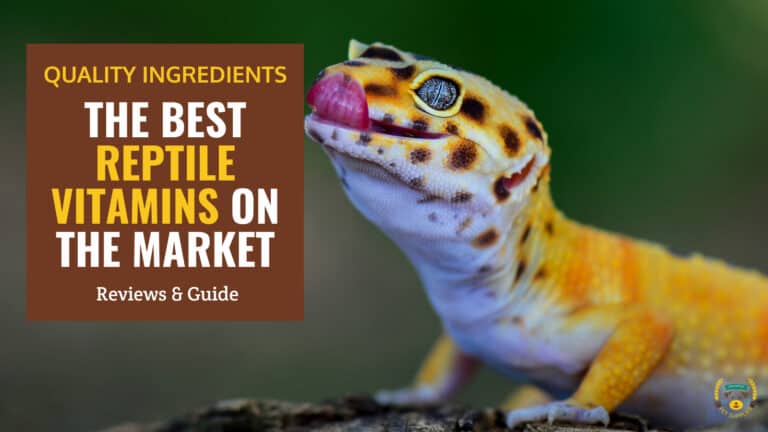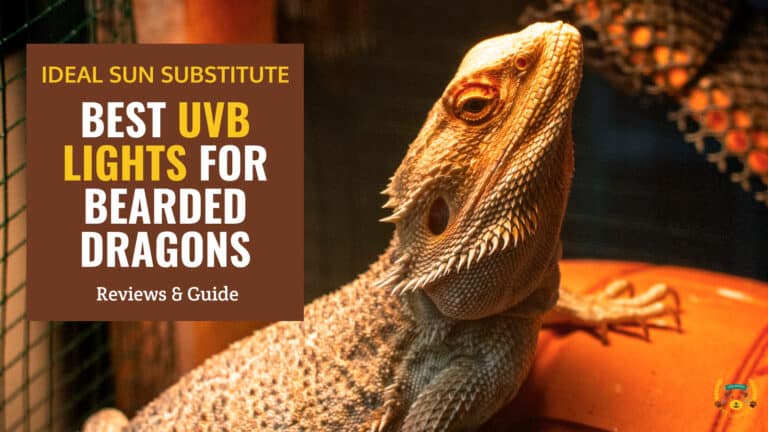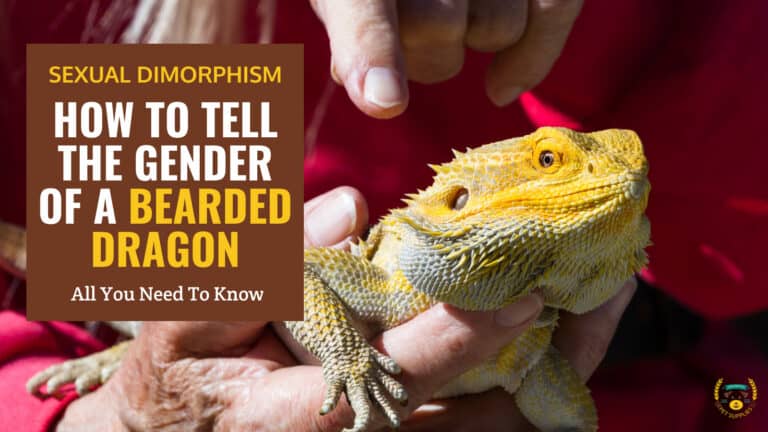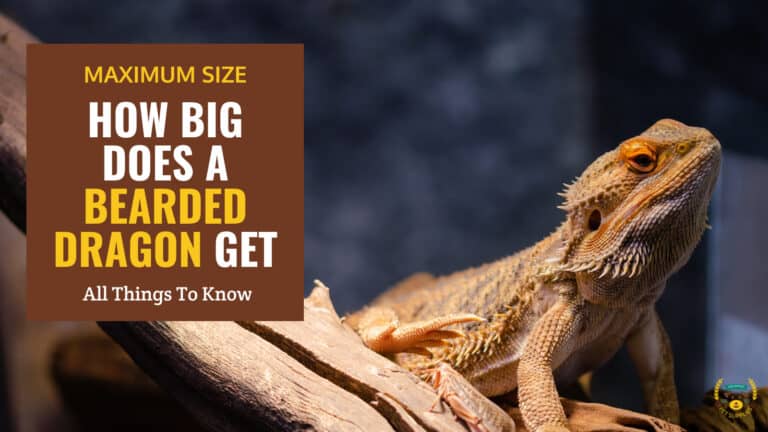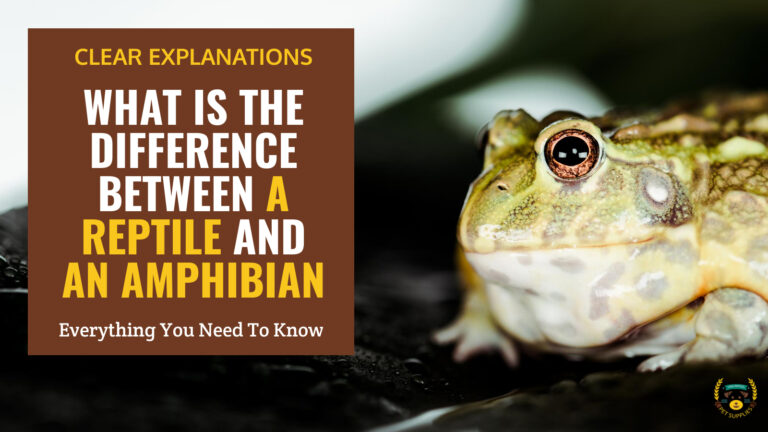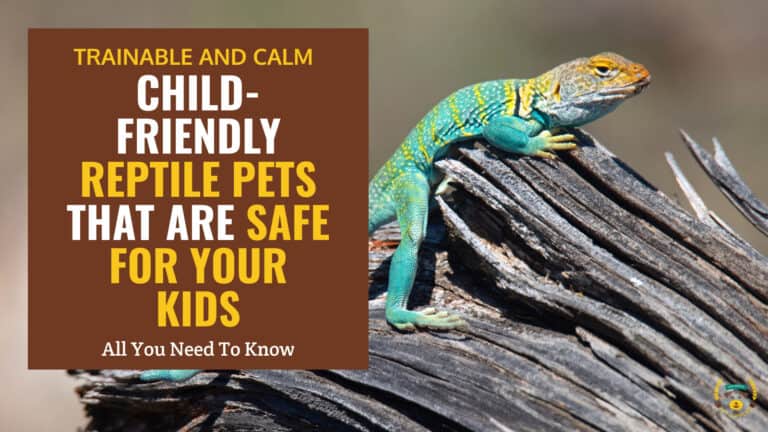The 10 Best Pet Snakes For Beginners (Pictures Inside)
Last updated: April 25, 2024
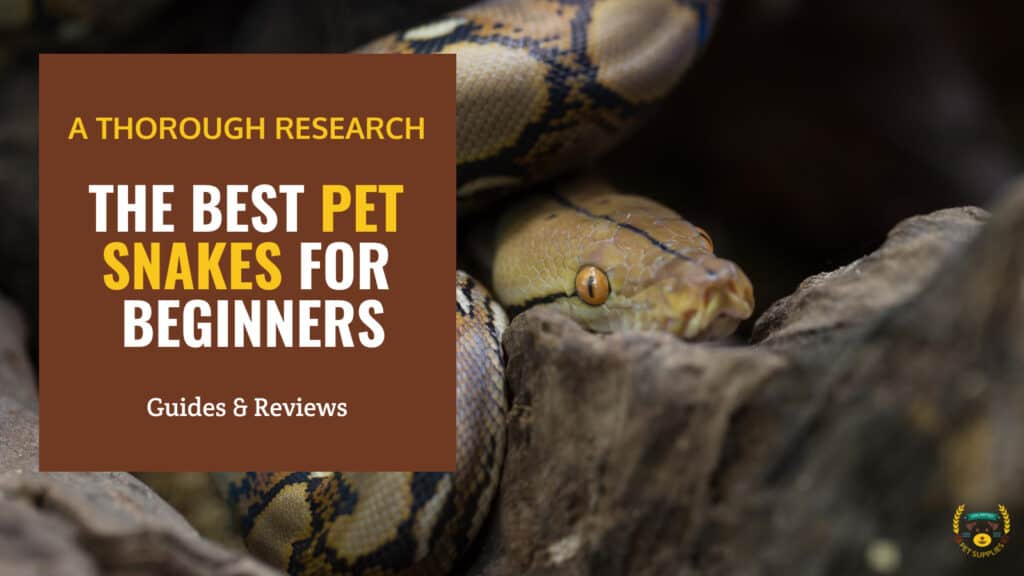
Summary
- Snakes can make great pets, but it is important to choose the right species for your lifestyle and experience level.
- Some snake breeds are considered illegal to be petted worldwide, like Yellow Anaconda, Russell Viper, Indian Cobra, and Common Krait.
- When choosing a snake pet, it is important to consider its size, temperament, diet, and care requirements.
- Snakes need lots of room to move around, so make sure you have a spacious snake cage with plenty of space to curl or climb and even hide in the special boxes.
- The most important thing is to provide the snake with enough food and water. You must also ensure that there is no danger from predators or humans.
Pet snakes are incredibly interesting animals. They come from a diverse range of species and can live for up to 20 years. Many snake owners enjoy having snakes around their homes due to their fascinating appearance and behavioral patterns.
Snakes, being beautiful and entertaining pets, provide companionship too. A friendly snake might be the perfect choice if you want to add some fun and excitement to your home.
Living with a pet snake is an adventurous choice and a fun and rewarding experience. The good thing about them is that they don't bite unless provoked. They also love to hide in places where humans cannot enter. Since they eat frozen mice and other small rodents, they are often kept as pets. If you have always wanted to try out having a pet snake in your life, read on to discover the top 10 snake species for beginners.
Can Snakes Be Good Pets For Beginners?
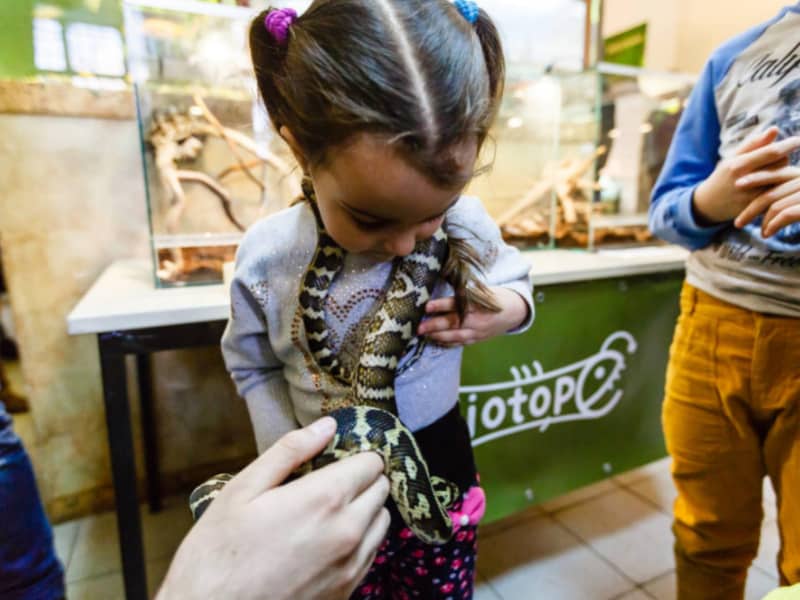
Yes, snakes can be great pets for beginners! There are many species of snakes available in pet shops today. They range in size, temperament, and personality. There are many benefits to having snakes as pets, including
- Loyal companions
- Excellent therapy animals
- Beautiful Patterns and markings on their skin
- Low-maintenance creatures
Living with reptiles requires patience, discipline, and lots of love. The best snakes for beginner snake keepers tend to be slow breeders who take months to reach full maturity. If you decide to get a pet snake, you should know that snakes are cold-blooded animals, just like fish or other reptiles. They don't produce heat internally; they rely solely upon their environment and other creatures around them for warmth, so ensure plenty of heat during the winter months. Snakes can be good pets, unlike some reptiles, because they have better docile temperaments than lizards and geckos.
However, for families specifically looking for a child-friendly option, it's important to explore reptiles that are known for being especially gentle and easy to handle. Learn more about gentle and harmless reptiles for a child's first pet.
The 10 Best Pet Snakes For Beginners
After thorough research, we have compiled a compelling list of non-venomous snakes that can be adopted as pet snakes, even if you have children or older people at home you are among first-time snake owners. Please take a look at the list provided and check some more information about their handling and behavior.
#1 Ball Pythons
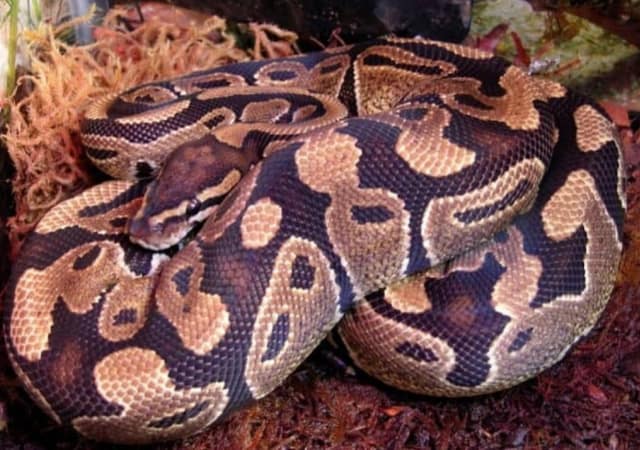
Scientifically known as Python Regius, Ball Pythons are our favorites to be adopted as pets. Their appearance, size, temperament, and overall behavior make them a popular choice as a pet for beginners.
Many snake enthusiasts consider ball pythons as one of the best pets due to their extraordinary features. The central and western Asian native species of snakes are, besides being non-venomous, an easy choice for beginner snake owners. If taken care of, they may live a happy life of 20–30 years, even in captivity.
Handling
Proper ball python handling is very important because it will affect their growth. They need a special type of terrarium. Don't ever try to keep more than one in the same enclosure. A proper enclosure is their basic necessity. They want to be kept in a temperature-controlled environment. 60 degrees Fahrenheit is the lowest temperature they can bear. Their cage should be kept warm enough using basing bulbs and humid enough through a misting tool.
Nature
When they feel threatened, ball pythons get curled up like a ball instead of attacking. They never bite their master or other humans unless in extreme conditions. They are only seen showing their wild nature when kept caged with another being of the same species. They don't tolerate each other. They are nocturnal species and get out of their hides usually at night.
Diet
The eating choices of a ball python may throw a challenge to herpetologists. For example, it may stop eating due to inappropriate temperature or lighting. When the quality or state of the provided prey or rodent is compromised, the ball python would stop eating. They like freshly killed or frozen rodents and other small reptiles. But, after all, that's what petting is all about, taking care of your pet just like a family member.
Putting serious attention to their diet is essential for optimal ball python growth and keeping them in good shape.
#2 Gopher Snake
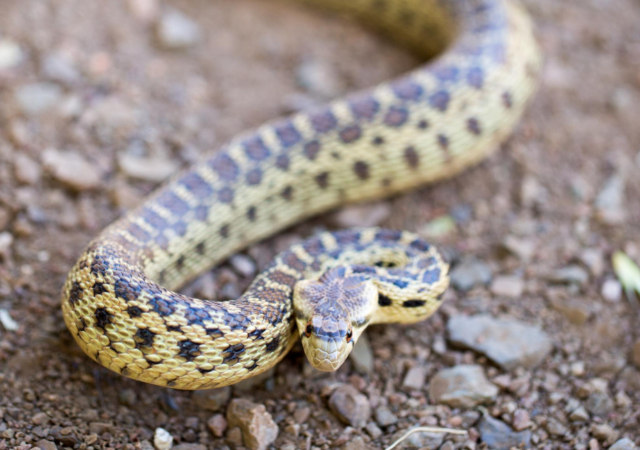
Pituophis catenifer is the scientific name given to the Gopher snakes. They are native to South America and some parts of Canada and North Mexico. They are mostly confused as being rattlesnakes. Some adult gopher snakes are said to have reached a length of 6 feet in extreme cases and have a lifespan of up to 25-30 years. Gopher snakes have beautiful markings on their bodies, which make them a favorite for beginner owners.
Handling
They are docile and never cause any harm to humans. If you are going to pet them, we advise you to comfort them and treat them gently. Their size might give you a dose of fear, but you must be patient and look out for the causes triggering your Gopher. With time, you will get to know each other and become great companions.
Gopher snakes like a 20-30 Gallon tank, which should be perfectly sealed since the breed is famous for performing smart escapes. Furthermore, their terrarium should have a loose and sufficient substrate level since they are accustomed to chasing their prey while burrowing on the land.
Nature
They are non-aggressive due to the absence of venom glands. However, they must not be adopted directly from the wild. The behavioral changes may trigger them and cause problems for the snake or the person who attempted to pet them. Instead, we advise beginners to get and adopt them from a trusted pet store so they are assured to be of the captive breed of gophers.
Diet
Gophers are named for a reason. They may eat gophers or other rodents in the wild. In captivity, an adult gopher would like to have large rodents frozen and thawed, and a baby gopher would be happy with pinky mice.
#3 Corn Snake
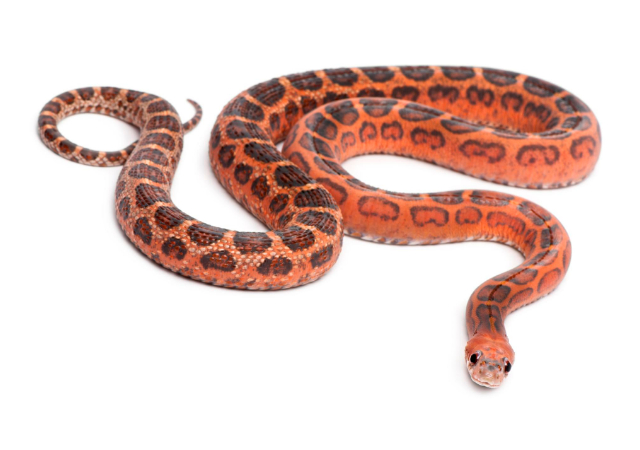
Having been scientifically named Pantherophis guttatus, Corn snakes are the most commonly available and easy-to-handle breed for beginners. Native to America, they are available in a variety of colors, especially the captive breed, which has many options in this regard. Naturally, they have orange as the base color with black and white patches.
Handling
Their size is the most incredible feature for beginner snake enthusiasts. An adult corn snake may grow to 4-5 feet in their lifespan. They usually don't mind being handled often. It makes them super-docile. They love to hide in their enclosures. You should design two hiding spots at least for them to be close to their original habitat.
Nature
They do like to behave nocturnally; that's why their enclosure should have switched to the lighting which further means that they should get little to no light at night time to help them practice their nocturnal behavior. Gophers can be great pets with their 20–30+ gallon tank. The only special feature their enclosure should have is two temperature zones, one around 75°F and the other being approximately 95°F.
Like many other docile breeds, they don't bite unless they feel stressed. They may hiss only in extreme conditions. You should work to find out the cause of their hissing. It is a sign that they are feeling threatened.
Diet
They are so-not-picky-eaters. Like most reptiles, their food choices are as simple as an adult mouse or quail. Freezing and thawing before serving is a must. The size of their prey must not exceed the widest portion of their body.
#4 Milk Snake
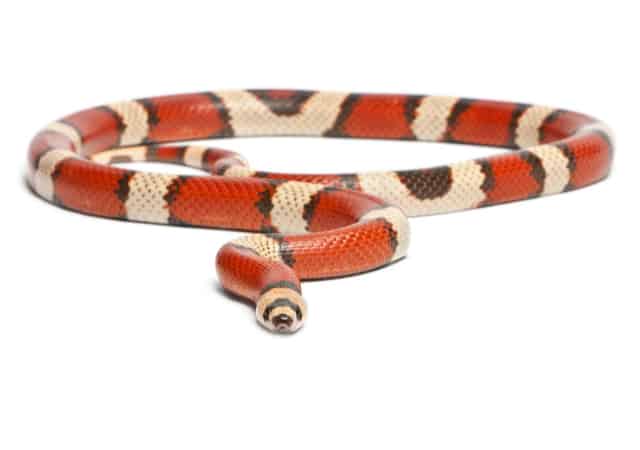
Lampropeltis triangulum is the name given to Milk snakes by scientists based on their kingdom and phylum classification. They are native to the Nearctic region, i.e., the Americas, Canada, and some parts of Mexico.
Before my research on this snake, I understood the reason for its name due to its skin color and patches. It also has regular whitish patterns all over its body. But, there, I learned about an old wives' tale about its name: it sucks human or cow breast milk till it dries completely. Of course, it has nothing to do with reality.
Handling
They like to have high humidity levels in their enclosure. A misted hide in their house will mimic their wild habitat. Milk snakes' tolerance toward higher temperatures is one striking and outstanding feature. Milk snakes must not be kept together in an enclosure. They can't tolerate another being of the same species in their enclosure. Mating is an exception.
They may, if handled gently, live up to 20–22 years in captivity. The maximum length recorded for the species is approximately 2 feet.
Nature
When young, milk snakes have brightly colored skin, which gets dull by the age of maturity, which is till 3–4 years old. Herpetologists have confirmed over 25 subspecies of milk snakes based on color variations.
Milk snakes are known for their calm nature, especially toward their human caregivers. But unfortunately, they usually get killed by humans on a misunderstanding of them as a venomous breed of copperhead or coral snake. They are like many other breeds and don't come out in the daytime.
Diet
Like many other breeds, milk snakes in the wild like to have mice, voles, lizards, and sometimes birds and their eggs, or even small venomous snakes. However, in captivity, they may conform to their prey's frozen and thawed form.
#5 Kenyan Sand Boas
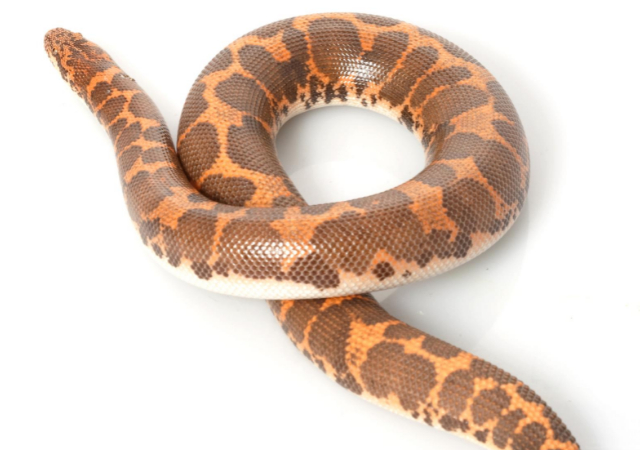
Eryx colubrinus is another name for this super-friendly and must-have breed for beginner snake enthusiasts. Native to the African region, beginners can definitely practice their snake enthusiasm with them. They don't grow above 2.5 ft. Males are even shorter and may reach a length of 16 inches approximately.
Handling
Kenyan sand boas are well-mannered towards humans in particular. They seldom like to be handled and would rather slip away than cause a bite threat to their handlers. If you want to mirror their habitat in the wild during captivity, you should keep sand in their enclosure in significant amounts. They like to have elevated temperatures in their tanks. So, a heat lamp is advised in their enclosure. They can live easily in a 10-gallon tank. Females might be happier in a 20-gallon enclosure.
Diet
Kenyan Sand Boas are named due to their love for burrowing in sand and even constricting their little prey by burying under the sand. They like to have lizards and rodents in captivity. However, boas in the wild can have anything relevant to their carnivorous nature.
Nature
They are mildly tolerant toward other beings of the same breed. Two males do not like to live together. However, two females can live in the same terrarium if treated equally. Caregivers must be knowledgeable about their breeding pattern. A female should be at least two years old to mate with a male who is around 12 months old.
#6 African Egg-Eating Snake
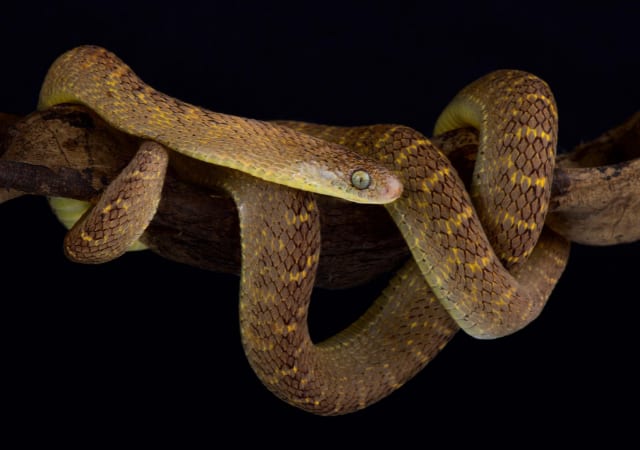
Native to central Africa, Dasypeltis fasciata, commonly known as the African Egg Eater Snake, is one of the exotic pets made captive. They are primarily found in forests, so Western Forest Eggeater is another identity given to them. They are low-maintenance and easy-to-handle species for a beginner.
Handling
African egg-eaters need special arrangements in their enclosure. They need more props to climb so that they may better mimic their natural habitat. They may reach a length of 2–2.5 feet at most. They can not harm or bite humans due to the unavailability of teeth. Plus, they are non-venomous. In this way, they are the most uncomplicated species to adopt for a beginner.
They go easy on their enclosure as well. A standard 20-gallon tank is enough for them to live. Moreover, adding some hide boxes and some natural substances as the substrate is a plus and provides them with an unstressed life in captivity.
Nature
Since they lack teeth, they can live with other beings of the same species in one tank. Attacking other beings is out of the question for them. The absence of teeth is for the easy and complete digestion of egg components. They can live up to 15 years if treated gently.
Diet
These egg-eating snakes, as their name suggests, are omnivores, i.e., they like to eat eggs only and nothing else. For that, they live in and around the dense trees where birds make nests. Furthermore, being nocturnal helps them prey on the eggs almost effortlessly since the birds are asleep and the eggs are unguarded.
Finch or quail eggs are their favorite prey. Chicken eggs are out of the question because their neck area is not wide enough. However, fully matured females can rarely have chicken eggs.
#7 California Kingsnake
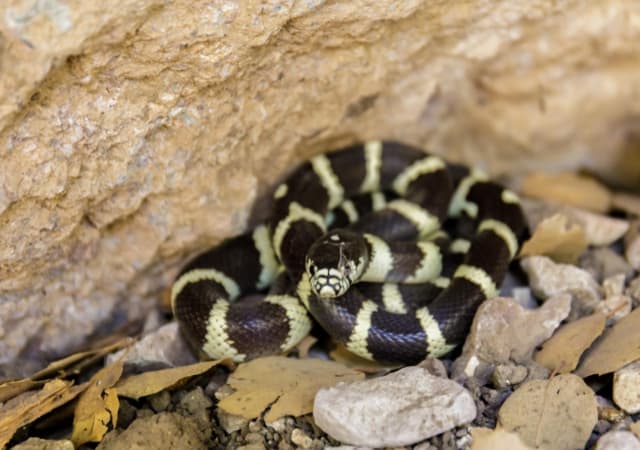
Lampropeltis getula California is the scientific name given to them. Commonly known as California Kingsnakes, they are true to their name, native to Southern America and some northern areas of Mexico. They are excellent for beginner snake lovers—easy to maintain and not overly demanding.
Handling
They are one of the most popular subspecies of king snakes, and they are found to be more docile than other king snakes when handled. They will happily accept a standard 20-gallon tank. They reach a length of 2–2.5 ft at full maturity. They usually don't bite unless threatened or attacked. Even if they do bite, it's not deadly or painful. However, proper training may make your decision to adopt them as a pet fruitful.
Nature
By appearance, they resemble corn snakes with black and brown skin and yellow stripes. They are non-venomous. One feature that makes them a different species from corn snakes is their non-nocturnal behavior. They like to come out of their hides in the daytime as well. The average age for California kingsnakes is almost 20 years.
Diet
Like many snake breeds, mice and small snakes are their favorite foods. While in the wild, they like to curl around and constrict their prey till death. However, a properly frozen and thawed mouse or other reptiles may fulfill their feeding needs. For example, an adult Kingsnake wants to have its rodent-based diet every 7–14 days, while babies may like to have pinkies every 5-7 days.
#8 Garter Snake
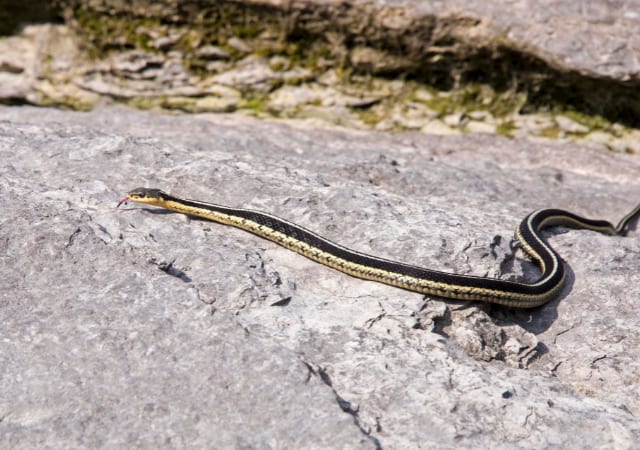
Thamnophis is the scientific name given to the Garter Snake, native to the Nearctic region. It is often known as the garden snake. You can find it in your backyard often. They are non-venomous, causing the least damage to humans. For that reason, they are again a great choice for beginners. They have bright color stripes running through their body length.
Handling
These little buddies may grow up to 1.5 to 2 feet. Seldom do they reach 4 feet in length. In the wild, they like to hide and live around marshes and meadows, so, to mimic their natural habitat, they want to have humidity props and basking lamps.
Nature
They enjoy the day and night equally. Garters can live in a range of temperatures. They can be found in any temperature region, from winters to spring and even summers. Like other cold-blooded breeds, they keep their bodies warm during the day under the sun in the wild and near basking lamps in captivity. They try to sleep in groups at night to keep the environment warm.
Diet
Common Garter snakes are also called friends of gardeners and farmers since they like to eat pests, worms, slugs, and leeches that disturb their plants. Besides that, they can enjoy a small fish-based diet and other amphibians as their food. However, unlike other breeds, they do not need mice or reptiles in their diet.
#9 Green Tree Python
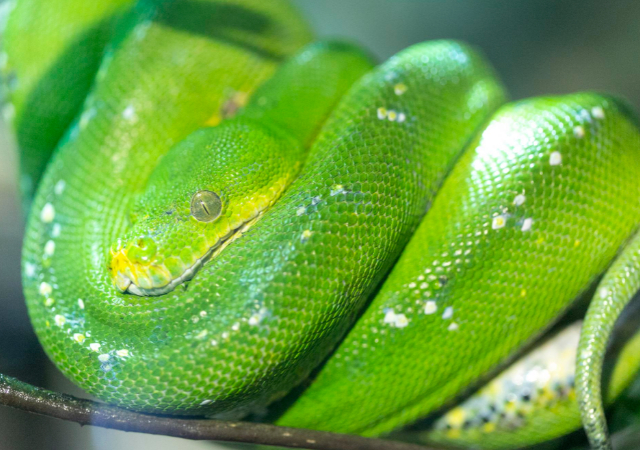
The scientific name given to this aesthetically pleasing snake breed is Morelia Viridis. They are little buddies, ranging from half a foot to approximately one foot. Green Tree Pythons a.k.a green snakes are only found in the rainforest region of Australia. True to their name, Green Tree Pythons are usually green in color with yellow stripes or blots, with occasional red being the color of some morphs.
Handling
Like other similar breeds, Green Tree Pythons do not like to be handled frequently. They are shy and can act weird when touched. However, their petting may end up as an adventure for most beginners.
Nature
Although green tree pythons are non-venomous, their bite is nasty and can cause some problems for human beings. Their lifespan is recorded to range from 15 to 20 years approximately. Being nocturnal they hunt at night like many other breeds.
Diet
Adult Green Tree Pythons have distinct dietary patterns. They like to have mammals, reptiles, and birds due to their enlarged jaw area, while baby green pythons are known to consume their hatchling mates.
#10 Rosy Boa
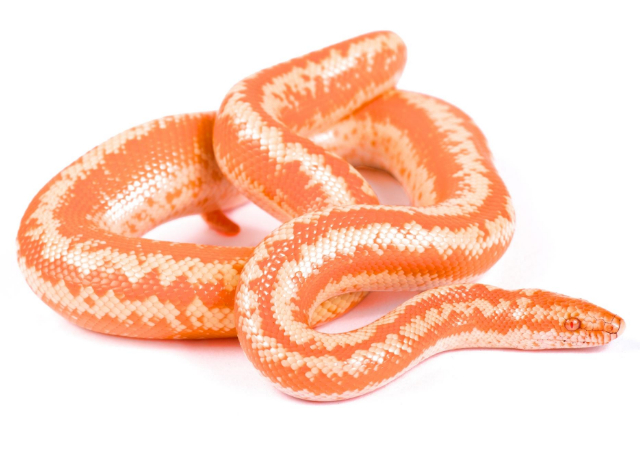
Charina Trivirgata is the name given to Rosy Boas. They are native to the southwestern United States and some northern parts of Mexico. Their lifespan is recorded to be 15–20 years in the wild and may reach 30 or more years in captivity with gentle care.
Handling
With the proper snake supply, reptile care, and well-being, this species flourishes as a beginner pet. They're small enough to handle easily. Adults may reach 1.5 to 3 ft. at a maximum. Most of the rosy boas are pretty tolerant of handling. However, they may get shy around their human caregivers in the beginning. That's why two weeks is prescribed for easy handling.
Nature
They tend to live near deserts and shrublands on rocks and hill fragments. A water source near these rocky areas is what they prefer. That's why their enclosure needs to be established in the same manner as their wild habitat-humid with stony props.
Diet
Rosy boas like to have small mammals for food such as rodents, baby birds, and lizards in the wild. Frozen and thawed prey can be a good choice as their food. Their hunting style is exclusive. They hold the prey with their teeth and curl their bodies around it to constrict. Then, after killing it, they swallow it as a whole.
Frequently Asked Questions
Although this article has enough information on keeping snakes as pets for beginners, we still would like to answer some of the frequently asked questions about herpetology.
Do Snakes Make Good Pets for Children?
Snakes are great pets if you want an animal that won't be dangerous. However, some types of snakes may be dangerous to some family members if they aren't properly trained, especially children or the elderly, whose reflexes are not up to the mark.
You should try to talk to the kids at home about the behavior and temperament of the snake breed. Also, most pet snakes are docile and tolerant toward handling, yet they don't like to be cuddled like a cat or dog. So, if you are going to get a snake for your child, you should supervise them all the time.
Is It Legal In My Area?
Before making any purchases, you should also consider where you live and whether purchasing a snake breed is legal in your area.
Some snake breeds are considered illegal to be petted worldwide, like Yellow Anaconda, Russell Viper, Indian Cobra, and Common Krait, because their presence or unfortunate escape might cause disturbance to the population. Still, if you want to adopt an exotic or a dangerous breed, you will need a special permit from the condo board to keep it at home.
But, we would advise you not to adopt a venomous snake breed only out of your interest and expertise in handling the species. Safety should be the priority.
Final Thoughts
As soon as you get a new pet, start slowly. Choose a snake species you're comfortable around and aren't afraid of. Learn about the natural behavior of these animals, and don't try to force them into unnatural positions or behaviors; they'll eventually figure out where they belong.
Snakes are very interesting creatures and will enjoy being with their caregivers. They can be kept in pairs, but only for mating. Snakes need lots of room to move around, so make sure you have a spacious snake cage with plenty of space to curl or climb and even hide in the special boxes. Ideally, the tank should have a volume of 20–25 gallons with unique props and temperature regularization equipment.
The most important thing is to provide the snake with enough food and water. You must also ensure that there is no danger from predators or humans. If possible, keep the snake away from cats and dogs.
Try and follow the advice given above and enjoy your herpetology hobby.

